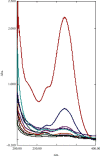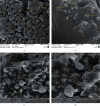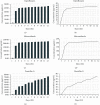An Innovative Drug Delivery System Loaded with a Modified Combination of Triple Antibiotics for Use in Endodontic Applications
- PMID: 32908513
- PMCID: PMC7469079
- DOI: 10.1155/2020/8859566
An Innovative Drug Delivery System Loaded with a Modified Combination of Triple Antibiotics for Use in Endodontic Applications
Abstract
The objective of the current study was to introduce "Polylactic co-Glycolic Acid- (PLGA-) Coated Ceramic Microparticles" as an innovative drug delivery system, loaded with a new combination of triple antibiotics (penicillin G, metronidazole, and ciprofloxacin (PMC)) for use in endodontic treatments. Ceramic microparticles were made from β-tricalcium phosphate and hydroxyapatite and examined by "Scanning Electronic Microscope (SEM)." Then, fixed amounts of the selected antibiotics were added to a prepared PLGA solution and stirred thoroughly. Next, the prepared ceramic microparticles were dispersed completely in the drugs solution. The deposited "PMC-loaded PLGA-coated ceramic microspheres (PPCMs)" were dried and incubated in phosphate buffer saline (PBS) for 21 days. The drug release from PPCMs was quantified by a UV spectrophotometer. The antimicrobial activity of PPCMs was investigated using the "Agar Plate Diffusion Test (ADT)," "Minimum Inhibitory Concentration (MIC)," and "Minimum Bactericidal Concentration (MBC)" against Enterococcus faecalis (E. faecalis) and Aggregatibacter actinomycetemcomitans (A.a). The cell viability test (MTT) was conducted for cytotoxicity against human gingival fibroblasts. SEM micrographs of PPCMs showed spherical-like ceramic microparticles with smooth surfaces. Crystal-like antibiotic particles (chunks) were also found on PPCMs. Initial burst of antibiotics (31 µg/mL, 160 µg/mL, and 18 µg/mL for ciprofloxacin, metronidazole, and penicillin G, respectively, in the first 4 days) followed by gradual and sustained release was observed within a period of 21 days. PPCMs demonstrated pH close to normal physiological environment and antibacterial activity against E. faecalis and A.a in the first 2 days. MTT showed cell viability of more than 70% for PPCMs after 24 h and 72 h of exposure. In conclusion, PPCMs demonstrated satisfactory release of antibiotics, antibacterial activity against the selected microorganisms, and biocompatibility. Thus, PPCMs may be used to deliver modified triple antibiotics to the root canal system for use in endodontic applications.
Copyright © 2020 Ardavan Parhizkar et al.
Conflict of interest statement
The authors declare that there are no conflicts of interest regarding the publication of this paper.
Figures






Similar articles
-
Antibacterial Efficacy of Polymer-Coated Ceramic Microparticles Loaded with a Modified Combination of Antibiotics on the Enterococcus faecalis Biofilm.Iran Endod J. 2023;18(2):85-90. doi: 10.22037/iej.v18i2.33041. Iran Endod J. 2023. PMID: 37152853 Free PMC article.
-
Comparison of Antibacterial Efficacy of Triple Antibiotic-Loaded Hydrogel Versus Modified Triple Antibiotic-Loaded Hydrogel as Intracanal Medicament Against Enterococcus faecalis: An In vitro Study.Eur Endod J. 2024 Mar;9(2):154-160. doi: 10.14744/eej.2023.06977. Eur Endod J. 2024. PMID: 38456465 Free PMC article.
-
In vitro behavior of poly-lactic-co-glycolic acid microspheres containing minocycline, metronidazole, and ciprofloxacin.J Investig Clin Dent. 2017 May;8(2). doi: 10.1111/jicd.12201. Epub 2016 Jan 7. J Investig Clin Dent. 2017. PMID: 26748575
-
Sustained Release of Risedronate from PLGA Microparticles Embedded in Alginate Hydrogel for Treatment of Bony Lesions.Iran Biomed J. 2022 Mar 1;26(2):124-31. doi: 10.52547/ibj.26.2.124. Iran Biomed J. 2022. PMID: 35090303 Free PMC article.
-
Phenomenology of the Initial Burst Release of Drugs from PLGA Microparticles.ACS Biomater Sci Eng. 2020 Nov 9;6(11):6053-6062. doi: 10.1021/acsbiomaterials.0c01228. Epub 2020 Oct 9. ACS Biomater Sci Eng. 2020. PMID: 33449671 Review.
Cited by
-
Human Treated Dentin Matrix Hydrogel as a Drug Delivery Scaffold for Regenerative Endodontics.Iran Endod J. 2022;17(4):185-194. doi: 10.22037/iej.v17i4.35580. Iran Endod J. 2022. PMID: 36703697 Free PMC article.
-
Local Drug Delivery Systems for Vital Pulp Therapy: A New Hope.Int J Biomater. 2021 Sep 15;2021:5584268. doi: 10.1155/2021/5584268. eCollection 2021. Int J Biomater. 2021. PMID: 34567123 Free PMC article. Review.
-
Local drug delivery for regeneration and disinfection in endodontics: A narrative review.J Conserv Dent Endod. 2025 Feb;28(2):119-125. doi: 10.4103/JCDE.JCDE_801_24. Epub 2025 Feb 3. J Conserv Dent Endod. 2025. PMID: 40046470 Free PMC article. Review.
-
Healing of large endodontic lesions using a new combination of triple antibiotics: A case report.Clin Case Rep. 2023 Jan 23;11(1):e6879. doi: 10.1002/ccr3.6879. eCollection 2023 Jan. Clin Case Rep. 2023. PMID: 36703762 Free PMC article.
-
Antibacterial Efficacy of Polymer-Coated Ceramic Microparticles Loaded with a Modified Combination of Antibiotics on the Enterococcus faecalis Biofilm.Iran Endod J. 2023;18(2):85-90. doi: 10.22037/iej.v18i2.33041. Iran Endod J. 2023. PMID: 37152853 Free PMC article.
References
-
- American Association of Endodontists. 6. Chicago, IL, USA: American Association of Endodontists; 2013. Guide to Clinical Endodontics.
LinkOut - more resources
Full Text Sources

